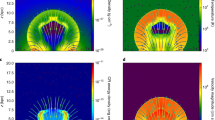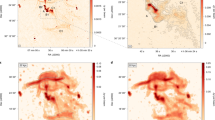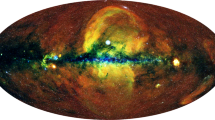Abstract
The first galaxies to appear in the Universe at redshifts z > 20 created ionized bubbles in the intergalactic medium of neutral hydrogen left over from the Big Bang. The ionized bubbles grew with time, surrounding clusters of dwarf galaxies1,2 and eventually overlapped quickly throughout the Universe over a narrow redshift interval near z ≈ 6. This event signalled the end of the reionization epoch when the Universe was a billion years old. Measuring the size distribution of the bubbles at their final overlap phase is a focus of forthcoming programmes to observe highly redshifted radio emission from atomic hydrogen. Here we show that the combined constraints of cosmic variance and light travel time imply an observed bubble size at the end of the overlap epoch of ∼10 physical Mpc, and a scatter in the observed redshift of overlap along different lines-of-sight of ∼0.15. This scatter is consistent with observational constraints from recent spectroscopic data on the farthest known quasars. This implies that future radio experiments should be tuned to a characteristic angular scale of 0.5 degrees and have a minimum frequency bandwidth of ∼8 MHz for an optimal detection of 21-cm flux fluctuations near the end of reionization.
This is a preview of subscription content, access via your institution
Access options
Subscribe to this journal
Receive 51 print issues and online access
$199.00 per year
only $3.90 per issue
Buy this article
- Purchase on Springer Link
- Instant access to full article PDF
Prices may be subject to local taxes which are calculated during checkout


Similar content being viewed by others
References
Barkana, R. & Loeb, A. Unusually large fluctuations in the statistics of galaxy formation at high redshift. Astrophys. J. 609, 474–481 (2004)
Furlanetto, S. R., Zaldarriaga, M. & Hernquist, L. The growth of H II regions during reionization. Astrophys. J. (2004) (submitted); preprint astro-ph/0403697 at 〈http://arxiv.org〉
Gunn, J. E. & Peterson, B. A. On the density of neutral hydrogen in intergalactic space. Astrophys. J. 142, 1633–1641 (1965)
Fan, X. et al. A survey of z > 5.7 quasars in the Sloan Digital Sky Survey III: discovery of five additional quasars. Astron. J. (2004) (in the press); preprint astro-ph/0405138 at 〈http://arxiv.org〉
Fan, X. et al. Evolution of the ionizing background and the epoch of reionization from the spectra of z ∼ 6 quasars. Astron. J. 123, 1247–1257 (2002)
Pentericci, L. et al. VLT optical and near-infrared observations of the z = 6.28 quasar SDSS J1030 + 0524. Astron. J. 123, 2151–2158 (2002)
White, R. L., Becker, R. H., Fan, X. & Strauss, M. A. Probing the ionization state of the universe at z > 6. Astron. J. 126, 1–14 (2003)
Zaldarriaga, M., Furlanetto, S. R. & Hernquist, L. 21 centimeter fluctuations from cosmic gas at high redshifts. Astrophys. J. (2003) (submitted); preprint astro-ph/0311514 at 〈http://arxiv.org〉
Morales, M. F. & Hewitt, J. Toward epoch of reionization measurements with wide-field radio observations. Astrophys. J. (2003) (in the press); preprint astro-ph/0312437 at 〈http://arxiv.org〉
Bond, J. R., Cole, S., Efstathiou, G. & Kaiser, N. Excursion set mass functions for hierarchical Gaussian fluctuations. Astrophys. J. 379, 440–460 (1991)
Gnedin, N. Y. Cosmological reionization by stellar sources. Astrophys. J. 535, 530–554 (2000)
Yoshida, N., Sokasian, A., Hernquist, L. & Springel, V. Early structure formation and reionization in a cosmological model with a running primordial power spectrum. Astrophys. J. 598, 73–85 (2003)
Wyithe, J. S. B. & Loeb, A. A large neutral fraction of cosmic hydrogen a billion years after the Big Bang. Nature 427, 815–817 (2004)
Mesinger, A. & Haiman, Z. Evidence for a cosmological Stromgren surface and for significant neutral hydrogen surrounding the quasar SDSS J1030 + 0524. Astrophys. J. Lett. (2004) (in the press); preprint astro-ph/0406188 at 〈http://arxiv.org〉
Miralda-Escude, J. On the evolution of the ionizing emissivity of galaxies and quasars required by the hydrogen reionization. Astrophys. J. 597, 66–73 (2003)
Barkana, R. & Loeb, A. GRBs versus quasars: Lyman-α signatures of reionization versus cosmological infall. Astrophys. J. 601, 64–77 (2004)
Bromm, V. & Loeb, A. The expected redshift distribution of gamma-ray burst. Astrophys. J. 575, 111–116 (2002)
Spergel, D. N. et al. First-year Wilkinson microwave anisotropy probe (WMAP) observations: determination of cosmological parameters. Astrophys. J. Suppl. 148, 175–194 (2003)
Acknowledgements
This work was supported in part by ARC, NSF and NASA.
Author information
Authors and Affiliations
Corresponding authors
Ethics declarations
Competing interests
The authors declare that they have no competing financial interests.
Rights and permissions
About this article
Cite this article
Wyithe, J., Loeb, A. A characteristic size of ∼10 Mpc for the ionized bubbles at the end of cosmic reionization. Nature 432, 194–196 (2004). https://doi.org/10.1038/nature03033
Received:
Accepted:
Issue Date:
DOI: https://doi.org/10.1038/nature03033
This article is cited by
-
A giant protocluster of galaxies at redshift 5.7
Nature Astronomy (2018)
-
Spectroscopic confirmation of an ultra-faint galaxy at the epoch of reionization
Nature Astronomy (2017)
-
The observable signature of late heating of the Universe during cosmic reionization
Nature (2014)
-
Spectroscopic confirmation of a galaxy at redshift z = 8.6
Nature (2010)
Comments
By submitting a comment you agree to abide by our Terms and Community Guidelines. If you find something abusive or that does not comply with our terms or guidelines please flag it as inappropriate.



